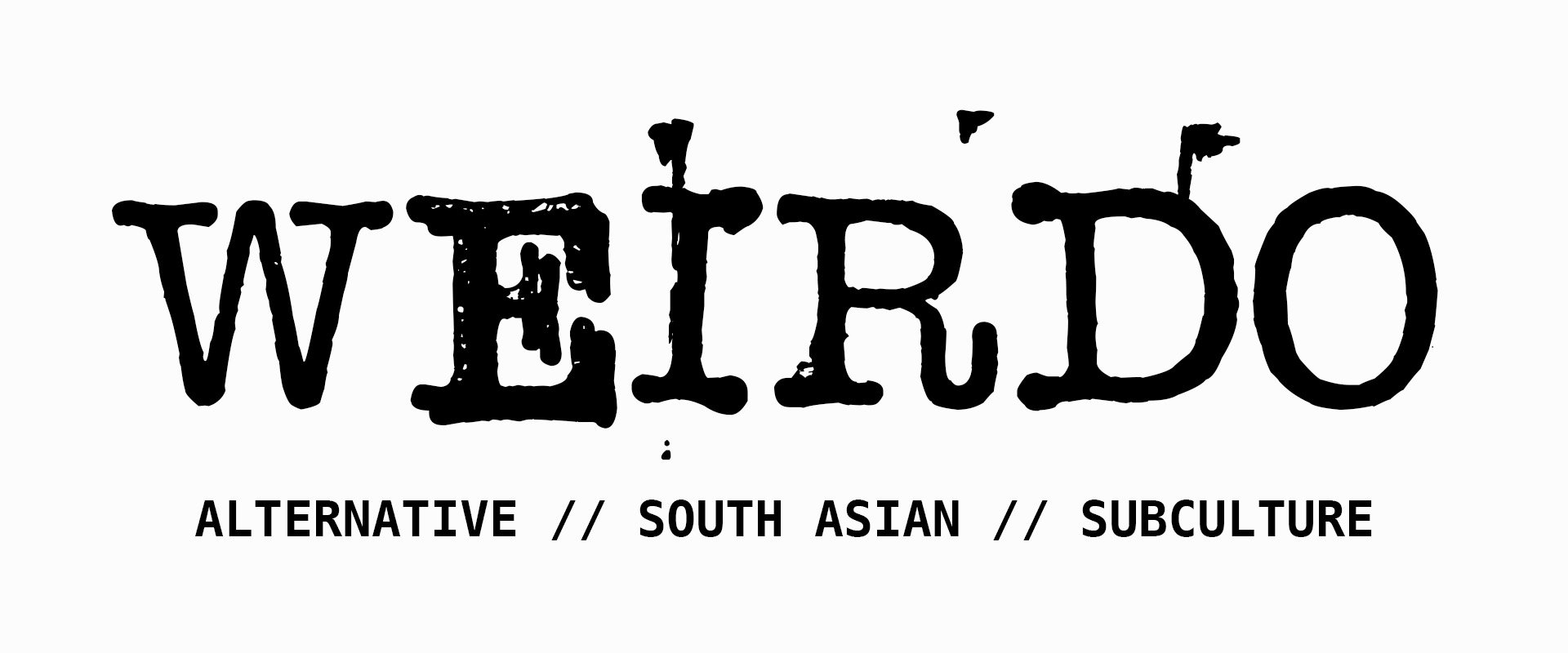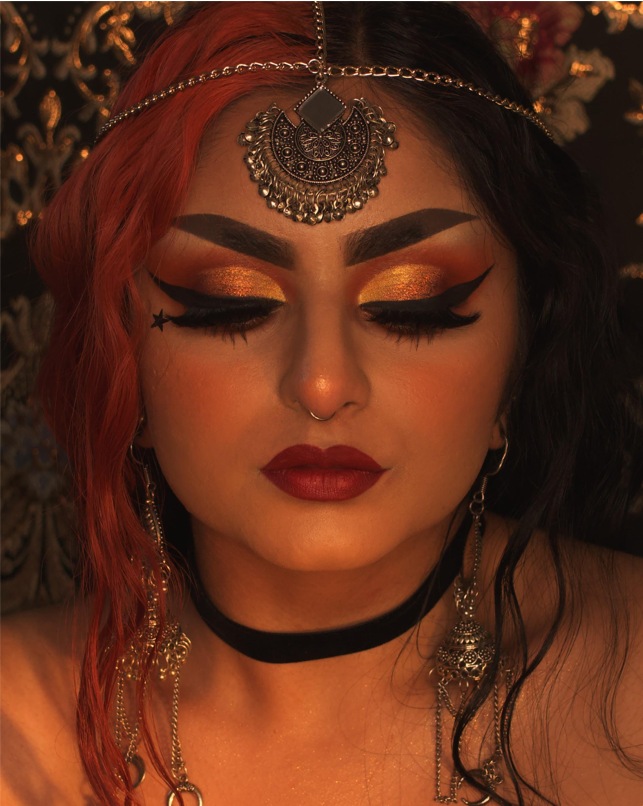Brown by birthright, not by bindi
Words and photos by Dil Kaur
@blingedoutlemons
There is no doubt in my genetic makeup that I am fully brown with both my Sikh-Punjabi parents. But is there doubt in my actual makeup application that I’m somehow not brown?
When I first took these photos, I loved them. The three-hour process of dolling myself up was a joy. I made the tikka with reference to those worn by Punjabi brides in my mum’s era. Though they were usually flashier and accompanied by a dupatta. My mum bought the earrings from an old lady by the street in Dehli and they’re so heavy that I never got the chance to wear them out. I used to love churiyaan, had a whole drawer of mismatched bangles that deserved more love. But alas, I didn’t have any to wear for these photos.
I initially wanted to write about us as alternative South Asians re-inventing oppressive standards of beauty by creating beauty within ourselves. But I think I chanced on something else while trying to get that happening. The more I was made to see myself in the light of traditional Punjabi beauty, the more I saw a reluctance to accept my image. I feel like I look like an absolute poser in those photos. Not a poser in the sense that I look like I’m trying to be edgy and it’s hella cringe, but like I’m trying very hard to look brown and “cultured” – I don’t think that’s fair. I don’t think it's fair that in my pursuit for individuality, I’ve somehow grown averse to that which I am.
I don’t think it's fair that in my pursuit for individuality, I’ve somehow grown averse to that which I am.
For me to talk about beauty standards within the South Asian community without addressing my privilege would be unjust. I am a Punjabi-Sikh woman who grew up in a first-world country, Singapore. I had access to the internet from a young age, which is where it all began, really. MySpace, Avril Lavigne, barbie.com and early YouTube tutorials. I have to mention now that my greatest find of 2011 was a video on how to turn bobby pins into fake piercing rings – fifteen-year-old Dil had a field day.
There is no doubt in my genetic makeup that I am fully brown with both my Sikh-Punjabi parents. But is there doubt in my actual makeup application that I’m somehow not brown? Maybe? Let’s discuss.
Autonomy in the way we present ourselves and the way we are perceived without consequence is a privilege.
For South Asian womxn, there’s more than just Fair & Lovely. There’s also Fair & Obedient, Fair & Conforming, Fair & Quiet. In my sphere of experience, the trifecta of success in being classified as the most beautiful Punjabi bride lies in being fair-skinned, obedient, conforming and quiet. I grew up being told I would want to grow into a woman who’s delicately beautiful, without an ounce of self-indulgence. Now, I don’t think my alternative lifestyle speaks to that at all. In communities where patriarchal and misogynistic norms still hold, individuality for womxn is not something that is easily achieved. Autonomy in the way we present ourselves and the way we are perceived without consequence is a privilege.
I sit here, looking at these gorgeous photos and I feel like I’m selling a lie. Why do I view my individuality as something so departed from my cultural roots?
I don’t mean to say that I don’t like how I look in traditional garb, I don’t think I like how I’m going to be seen in a more traditional light. In my fight for visibility, having my race seen before my other defining factors was always seen as a negative. I didn’t want to be the “Indian goth girl” while my peers got to just be “goth girl”. I hated that my individuality came after my racial classification. As I grew older, I found comfort in my identity as a goth brown makeup hoe-kage. My passions shifted towards celebrating my roots and engaging with my cultural identity beyond colonialist thinking. I didn’t want to see myself as an “other” – I wanted to be seen as I am. All that self-empowerment aside, it would still happen: I would just be the “brown” one. Unable to move from a label so definitive to my personality, yet so restrictive of my potential. So, I sit here, looking at these gorgeous photos and I feel like I’m selling a lie. Why do I view my individuality as something so departed from my cultural roots?
I’m a proud Punjabi woman whether or not my entire visual aesthetic is formulated around the colours black and red. I am not forgoing my roots by choosing to present differently from girls my age.
From the day I was aware of my female self, I was told my body was not mine to consider. I wasn’t to wear anything revealing, for fear of wandering eyes. I wasn’t to think to wear anything beyond what was necessary, for fear of rebellion. I wasn’t to stray from what was known, for fear of shame. These were beliefs that I still hold indicative of my South Asian upbringing. Now that I’ve crossed these barriers into what I think is my idealised self, it is hard to go back to appreciating the very aesthetic that framed these oppressive beliefs. When I see myself as a beautiful Punjabi woman, I see defeat. I see myself conforming into what I was supposed to be. But I can’t stress this enough that this should NOT be the case. I don’t think it’s fair that I link the beauty in my culture to the oppression that it also harvests. I also don’t think it’s fair that I should feel to lose any of my individuality in choosing to participate in my culture. But in adding to that, I don’t think my aversion to Hindi or Punjabi music defines how brown I am. I don’t think the glamorised Bollywood aesthetic of giant tikkas and perfectly mehendi-ed hands should be signifying visuals of culture. That’s a sad way to encompass lineages of rich history. And a sad way to dismiss emerging cultural icons. You see I didn’t grow up close to my roots. I grew up in South East Asia and was forced to worship straight-from-the-source capitalist cultural exports where preserving culture has become knowing all the words to Kal Ho Naa Ho. We get excited to wear a lengha to post a boomerang doing a twirl. But what is any of this doing for the legacy that we are building for the generations to come?
I want to do more for my culture’s history, I want to tell the stories left forgotten under colonialism. I want to do more to preserve what I have for the generations to come and I want individuality to be a welcomed part of that. For that, I think we need to think more about the culture we are creating now. I do not need to wear a bindi on my head to cement my identity as a Punjabi woman. I’m a proud Punjabi woman whether or not my entire visual aesthetic is formulated around the colours black and red. I am not forgoing my roots by choosing to present differently from girls my age. South Asian women can indulge in their individuality without being perceived as “uncultured” or “westernised”.
We’re brown by birthright, not by bindi.
About Dil
Dil self identifies as a goth brown makeup hokage who just wants Avril Lavigne to be recognised for her contributions to humanity. When she is not searching for the perfect orange blush, Dil is working on a master's degree in Cultural and Creative Industries. Dil is particularly interested in discourse surrounding marginalized artists, media representation, and decolonization. She's also one of those people who abuses the peace sign aggressively.



